





The Secret Garden - what did it really look like? If you've read the book, you remember the bricked-up secret garden which came to life when tended by Mary Lennox. If you haven't, perhaps I can convince you to pick up a copy somewhere and read it! Although it's a children's book, it has captivated the hearts of gardeners for generations. Here are some photographs of what the adult in me thinks the flowers in Mary's Secret Garden might have looked like.
Did you grow up with this book? I did. My mother tells me that my paternal grandmother—the one who had some lovely gardens herself—gave me The Secret Garden for my birthday when I was six or seven, and then started reading it to me. Maybe that's why I like gardens so much. When I read it as a child, though, I had no idea what rose bushes, delphiniums or poppies looked like.
Growing up in the 1960s, I didn't know about perennials or annuals, let alone that there was a difference. Allegedly flowers and vegetables came from seeds, but roses only came in bouquets or corsages, and lilies were for Easter. My parents didn't garden. But sometime, someone had planted snowdrops and crocuses in the yard of our big old house, and they came up every spring. So when Mary found her first snowdrop in The Secret Garden, I was hooked.
As children, lots of us read The Secret Garden by Frances Hodgson Burnett, first published in 1909, one hundred years ago this year. Most of us read the version pictured here, illustrated in 1963 by Tasha Tudor, who just recently passed away, in June of 2008. The secret garden even became a psychological metaphor of sorts, and many of us have our own "secret garden", whether it be a complete walled garden or a corner of a room. The book itself undoubtedly inspired a love of gardening in many people, the way it did in me. That secret garden in Yorkshire, lovingly tended by orphaned Mary Lennox, her cousin, sickly Colin Craven and their friend from the village, Dickon—what might it really have looked like? With the help of PlantFiles and other pictures, let's try to find out. "Mistress Mary, quite contrary, Soon, sallow, contrary, disagreeable young Mary sails for England (which she has never heard of) to stay with her uncle "Mr. Archibald Craven" who is "a hunchback, and horrid," according to the other children. It is late winter or very early spring when Mary arrives at Misselthwaite Manor. It is her Yorkshire maid, Martha, who first explains to Mary that "one of the gardens is locked up. No one has been in it for ten years. ... Mr. Craven had it shut when his wife died so sudden. ... He locked th' door an' dug a hole and buried th' key." Mary's robin redbreast is a European robin, Erithacus rubecula, like the one in the picture above. Erithacus rubecula has much redder feathers and is not related to its American namesake, Turdus migratorius. She notices, as she twitters to the robin, that there is a tree branch from which he can chirp to which none of the paths seem to lead. Is he, perhaps, singing inside the secret, locked-up garden? Her search becomes more focused. She wonders if it is "quite dead" after being abandoned for ten years. One day, as Mary is taking one of her long walks about the grounds and talking to the robin, she sees him digging for worms, and catches sight of a very old key which he has just dug up. Then not much later, on a windy, gusty day, she finds "the robin swaying on a long branch of ivy." A "strong gust of wind ... swung aside some loose ... trailing sprays of untrimmed ivy hanging from the wall." A door of wood and iron is revealed, under a "swinging curtain of ivy." The old key, which she has been carrying in her pocket, fits perfectly, the door opens, and "she slipped through it" Old Ben Weatherstaff has described the coming of springtime to Mary: "in th' flower gardens out there things will be stirrin' down below in th' dark. ... You'll see bits o' green spikes stickin' out o' th' black earth' after a bit. ... Crocusses an' snowdrops an' daffydowndillys." Mary is entranced with the bulbs' progression from tiny shoot to stalk to bud to flower. She is rewarded with snowdrops and with crocuses of royal purple and gold. Like the flowers she is watching unfold, Mary herself is growing, thriving and transforming into a healthy, glowing, cheerful, rosy-cheeked Yorkshire lass. One day, after digging in the garden, Mary asks her maid, Martha, "what are those white roots that look like onions?" and Martha answers, "th' very little ones are snowdrops an' crocuses an' th' big ones are narcissus an' jonquils an' daffydowndillys. Th' biggest of all is lilies an' purple flags. Eh! they are nice. Dickon's got a whole lot of 'em planted in our bit o' garden. ... Our Dickon can make a flower grow out of a brick walk." Mary gets the idea of making the secret, dead-looking garden come alive again. She tells Martha "if I had a little spade ... I might make a little garden." Mary has already decided she must keep the discovery of the garden a secret—she is afraid someone will take it away or lock it up again. Once Mary finds her way into the Secret Garden, she begins to discover that although it has been neglected for ten years, it is not dead, but only sleeping. She sees bushes she recognizes as roses, and wonders whether they could possibly still be alive. What a quandary for Mary! Should she keep the garden a secret? Should she trust this stranger, a boy, with her biggest secret? But he has already been nice to her, he has bought the tools and seeds for her, he knows how to use them, and he can charm wild animals and talk to the robin! He explains to Mary, "I'm keepin' secrets all th' time. ... If I couldn't keep secrets from th' other lads, secrets about foxes' cubs, an' birds' nests, an' wild things' holes, there'd be naught safe on th' moor. Aye, I can keep secrets." Dickon tells Mary that her secret is as safe with him as the nest of a missel thrush (from which Misselthwaite Manor gets its name). And so, Dickon becomes the second person to see the secret garden. "It's a queer pretty place!" Dickon whispers, when Mary first shows him in. ... "'Eh! the nests as'll be here come springtime,' he said. It'd be the safest nestin' place in England. No one never comin' near an' tangles o' trees an' roses to build in. I wonder all th' birds on th' moor don't build here.' ... Mary and Colin are both just ten years old, and are first cousins, although they have never met before. They find some gardening books in one of the abandoned rooms in the enormous manor. Colin is partial to "del-phin-i-ums," which he has seen in a book. Although the garden is, of course, primarily a rose garden, it is filled with perennials and annuals, all of which have been left to themselves. Dickon identifies clumps of columbine which, he says, will "look like a bed 'o blue an' white butterflies flutterin'." And so Colin, who "hates fresh air," is the third person in on the secret. It takes a lot of mysterious planning on the part of the three children as to exactly how they will get him outside and into the garden secretly. Colin simply declares that he likes fresh air when he is with his cousin Mary, and that Dickon will be pushing his wheeled chair. Everyone knows that Dickon is dependable and as strong as a moor-pony. Dickon knew all along about the Magic of spring and the life inside a tiny seed. Mary has seen snake charmers and magicians in India, and is ready to believe in Magic. Colin says "there is Magic in there—good Magic." Throughout the summer the children enjoy themselves and the garden, and get healthier and stronger. (One problem Colin and Mary encounter is as their vigor increases, so do their appetites. The kitchen staff is accustomed to having Colin send back most of his trays uneaten. The secret might be out if he starts requesting second helpings! The solution is that Dickon and Martha's mother begins to make extra food for them, and Dickon buys food for them in the village. Now they are able to continue their disdain for the fancy food sent up from the kitchens!) When my grandmother read me this book, and when I read it again as an older child, I had only my imagination to illustrate it. Now that I have grown poppies, delphiniums and roses, and experienced many other gardens filled with flowers, I have a clearer picture of what the secret garden could have, might have looked like. I urge you to reread your copy if you have one or get one if you don't. Read it to yourself or to any children who will sit still. The Secret Garden is filled with timeless themes of rebirth, making friends and, of course, GARDENING. Read reviews of The Secret Garden in The Garden Bookworm This week, the writers here at Dave's Garden are celebrating Gardening Book Month. Be sure to read . . . Plant Select's new book: A resource for all gardeners by Suzanne Talbert. Gertrude Jekyll - my garden inspiration by Jan Recchio. Henry Mitchell by Marie Harrison. Introduction to the Modern Library Gardening Series by Benjamin Hill. Enjoy garden and nature books, but save some money for the plants by Sally G. Miller. The cover image illustration by Tasha Tudor is the property of HarperCollins Publishers and used with permission. All quotations are from the text of The Secret Garden. Read it free here. Picture credits gratefully go to adinamiti, Aunt_A, bentleygardens, Bookerc1, Calif_Sue, carrielamont, critterologist, Dinu, gallesfarm, Kathleen, kqcrna, melvatoo, Mrs_Ed, pixie62560, rannveig, sallyg, Sharran, TBGDN, threegardeners, Todd_Boland, and wallaby1! (Editor's Note: This article was originally published on March 23, 2009. Your comments are welcome, but please be aware that authors of previously published articles may not be able to respond to your questions.) 















 Mary is the only child of a British army officer and his glamorous wife. They live in India, where it is always "frightfully hot". Mary is waited on by her Ayah, or Indian nursemaid.
Mary is the only child of a British army officer and his glamorous wife. They live in India, where it is always "frightfully hot". Mary is waited on by her Ayah, or Indian nursemaid.  One odd day, no one comes to care for Mary. The cholera has broken out, suddenly, and everyone, her parents, the servants, everyone has died. There is no one left.
One odd day, no one comes to care for Mary. The cholera has broken out, suddenly, and everyone, her parents, the servants, everyone has died. There is no one left.
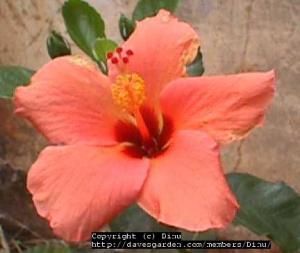
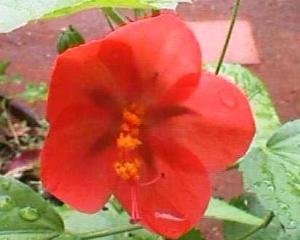
Mary Lennox is first sent to stay with an English clergyman's family. Still in India, she plays at making a garden, sticking "big scarlet hibiscus blossoms into little heaps of earth." The other children tease her, singing:
How does your garden grow?
With silver bells, and cockle shells,
And marigolds all in a row."
Her uncle has a "grand big place in a gloomy sort of a way ... The house is six hundred years old ... and there's near a hundred rooms in it," explains Mrs. Medlock, who has been sent from Misselthwaite Manor in Yorkshire to fetch Mary from London. 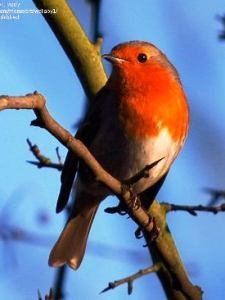
Mary takes a walk and finds herself "in great gardens ... but the flowerbeds were bare and wintry." This is also the occasion when she meets the robin! Ben Weatherstaff, the estate's old gardener, says robins are "th' friendliest, curiousest birds alive."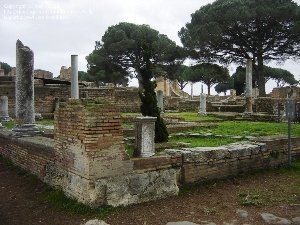
Mary is scrawny and yellow and unpleasant and there is nothing to do and nobody to entertain her. On clear days she walks or skips among the estate's vast gardens, talking to the robin and working up an appetite for the first time in her life. She is idly searching for the garden which has been locked up for ten years—for as long as she has been alive.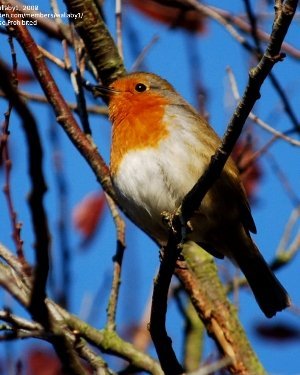
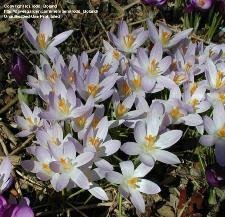
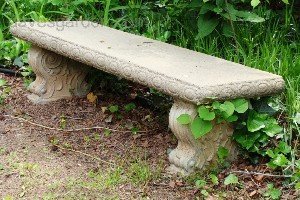 "She was standing inside the secret garden. It was the sweetest, most mysterious-looking place anyone could imagine. The high walls which shut it in were covered with the leafless stems of climbing roses which were so thick, that they were matted together. ... There were ... trees in the garden, and one of the things which made the place look strangest and loveliest was that climbing roses had run all over them and swung down long tendrils which made light swaying curtains."
"She was standing inside the secret garden. It was the sweetest, most mysterious-looking place anyone could imagine. The high walls which shut it in were covered with the leafless stems of climbing roses which were so thick, that they were matted together. ... There were ... trees in the garden, and one of the things which made the place look strangest and loveliest was that climbing roses had run all over them and swung down long tendrils which made light swaying curtains." 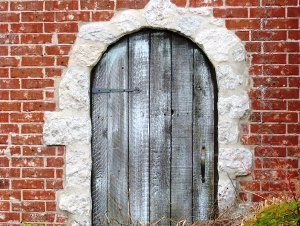 "'I am the first person who has spoken in here for ten years.' Mary whispered" She discovers grass paths, stone seats, flower beds, and "sharp little pale green points" ... "sticking up out of the black earth." Instinctively, Mary clears the grass away from the emerging shoots.
"'I am the first person who has spoken in here for ten years.' Mary whispered" She discovers grass paths, stone seats, flower beds, and "sharp little pale green points" ... "sticking up out of the black earth." Instinctively, Mary clears the grass away from the emerging shoots.
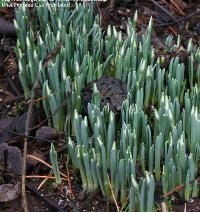
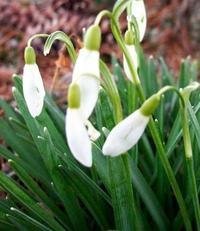
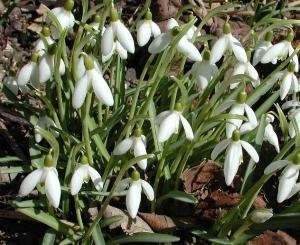
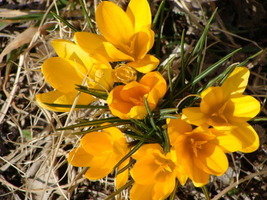
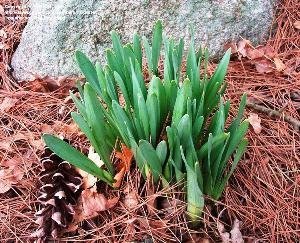
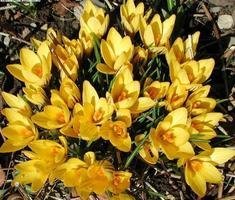
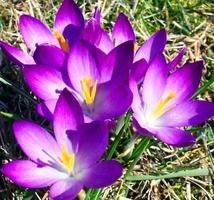
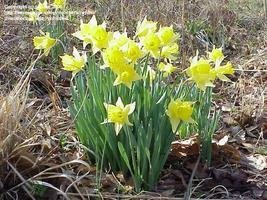
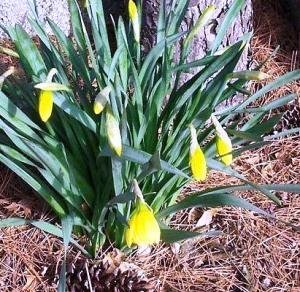
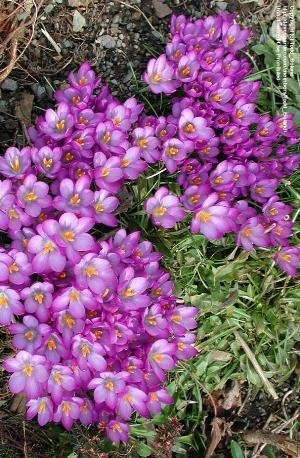
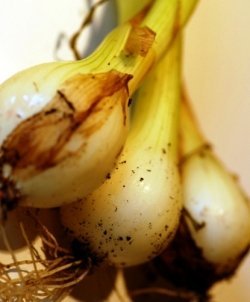
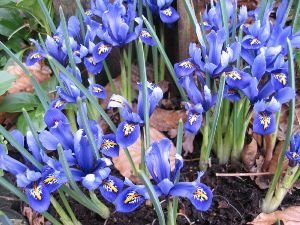
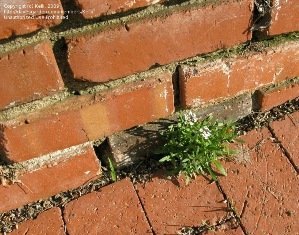
Martha answers "I saw little garden sets with a spade an' a rake an' a fork all tied together for two shillings. ... They sell packages o' flower seeds for a penny each, and our Dickon knows which is th' prettiest ones an' how to make 'em grow." 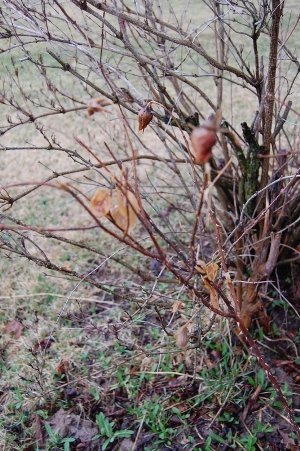
(She is familiar with roses in India, but they never went through dormancy there.)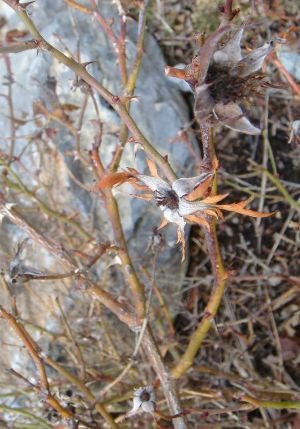 So it is Martha's brother Dickon himself who brings Mary the tools, along with a collection of seeds. He brings seeds for poppies, blue larkspur, mignonette, and then "he told her what they looked like when they were flowers, he told her how to plant them, and watch them, and feed and water them."
So it is Martha's brother Dickon himself who brings Mary the tools, along with a collection of seeds. He brings seeds for poppies, blue larkspur, mignonette, and then "he told her what they looked like when they were flowers, he told her how to plant them, and watch them, and feed and water them."
"'See here,' he said suddenly, turning around to look at her. 'I'll plant them for thee myself. Where is tha' garden?'" 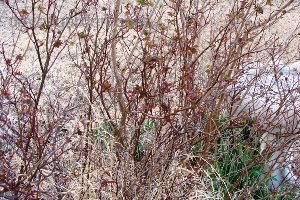
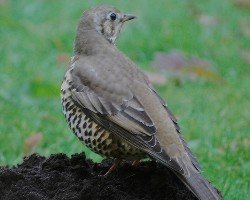
'Will there be roses?' she whispered. ... 'I thought perhaps they were all dead.'...
'This here's a new bit,' and he touched a shoot which looked brownish green instead of hard, dry gray.'" He takes out his pocket-knife and shows Mary how beneath the gray, brown surface runs a layer of green. These branches, he explains, are "wick," or alive.
"I want them all to be wick" cries Mary. 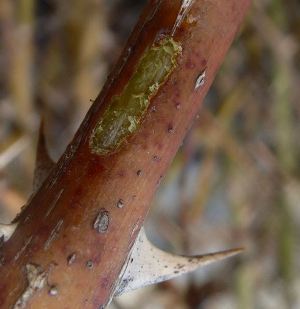 And so Dickon and Mary "go round the garden and count how many wick ones there are."
And so Dickon and Mary "go round the garden and count how many wick ones there are."
"'They've run wild,' he said, 'but th' strongest ones has fair thrived on it. The delicatest ones has died out, but th' others has growed an' growed, an' spread an' spread, till they's a wonder. ... There'll be a fountain o' roses here this summer.'"
Mary spends a lovely afternoon with Dickon in the garden.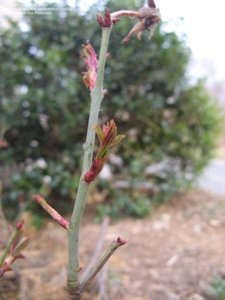 Then it rains, and Mary cannot go to the secret garden. Instead, she explores some of the 100 rooms in Misselthwaite Manor, and discovers another secret: her cousin, the sickly invalid, young Colin Craven. He is not expected to live, he tells her. Neither of them has ever played with other children before, but after a rough start, they become fast friends
Then it rains, and Mary cannot go to the secret garden. Instead, she explores some of the 100 rooms in Misselthwaite Manor, and discovers another secret: her cousin, the sickly invalid, young Colin Craven. He is not expected to live, he tells her. Neither of them has ever played with other children before, but after a rough start, they become fast friends 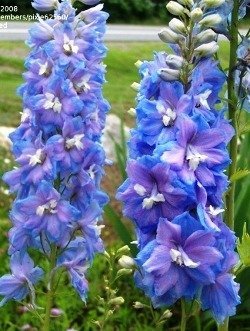
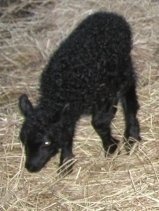 Dickon comes to visit Colin, along with a fox, a crow, two tame squirrels and a newborn lamb! He tells Colin that there are some clumps of delphiniums established in the secret garden already. He also explains that delphiniums are "larkspurs made big and grand."
Dickon comes to visit Colin, along with a fox, a crow, two tame squirrels and a newborn lamb! He tells Colin that there are some clumps of delphiniums established in the secret garden already. He also explains that delphiniums are "larkspurs made big and grand."
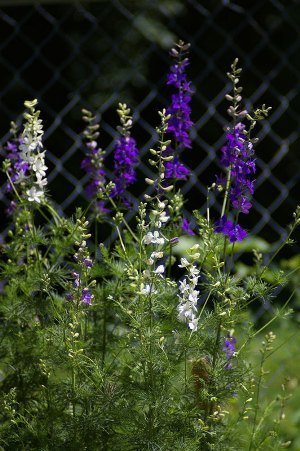
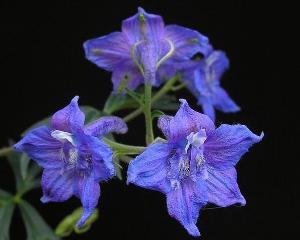
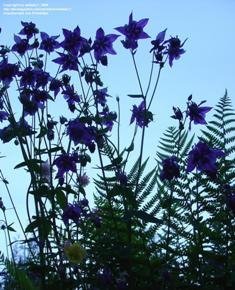
Ben Weatherstaff surprises the three children on their first day together in the secret garden. Colin, fretful, sickly Colin who did not believe he would live to grow up, rises, literally, to this confrontation. He stands up and shows Ben that neither his back nor his legs are crooked. Ben Weatherstaff is moved to tears. "He choked and gulped and suddenly tears rolled down his weather-wrinkled cheeks ... 'The lies folks tells! ... Tha'lt make a mon yet.'" Ben says.
So Ben Weatherstaff is the fourth person—and the first adult—to learn about the key and the door and that the secret garden has come back to life!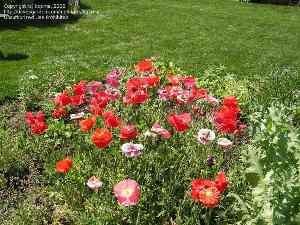
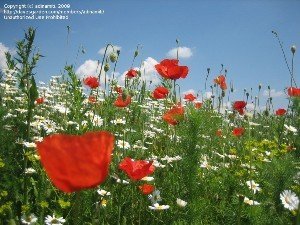 "They always called it Magic and indeed it seemed like it in the months that followed. ... At first it seemed that green things would never cease pushing their way through the earth, in the grass, in the beds, even in the crevices of the walls. Then the green things began to show buds and the buds began to unfurl and show color, every shade of blue, every shade of purple, every tint and hue of crimson. ... Iris and white lilies rose out of the grass in sheaves, and the green alcoves filled themselves with amazing armies of the blue and white flower lances of tall delphiniums or columbines or campanulas. ...
"They always called it Magic and indeed it seemed like it in the months that followed. ... At first it seemed that green things would never cease pushing their way through the earth, in the grass, in the beds, even in the crevices of the walls. Then the green things began to show buds and the buds began to unfurl and show color, every shade of blue, every shade of purple, every tint and hue of crimson. ... Iris and white lilies rose out of the grass in sheaves, and the green alcoves filled themselves with amazing armies of the blue and white flower lances of tall delphiniums or columbines or campanulas. ...
The seeds Dickon and Mary had planted grew as if fairies had tended them. Satiny poppies of all tints danced in the breeze by the score, gaily defying flowers which had lived in the garden for years and which it might be confessed seemed rather to wonder how such new people had got there. ..."
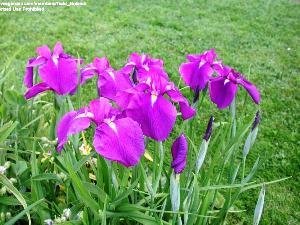
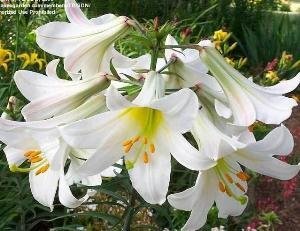
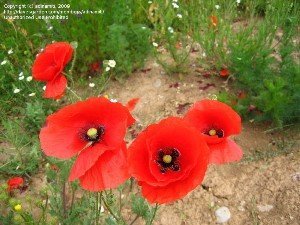
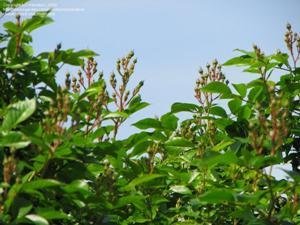 "And the roses—the roses! Rising out of the grass, tangled 'round the sun-dial, wreathing the tree trunks and hanging from their branches, climbing up their walls and spreading over them with long garlands falling in cascades—they came alive day by day, hour by hour. Fair fresh leaves, and buds—and buds—tiny at first but swelling and working Magic until they burst and uncurled into cups of scent delicately spilling themselves over their brims and filling the garden air."
"And the roses—the roses! Rising out of the grass, tangled 'round the sun-dial, wreathing the tree trunks and hanging from their branches, climbing up their walls and spreading over them with long garlands falling in cascades—they came alive day by day, hour by hour. Fair fresh leaves, and buds—and buds—tiny at first but swelling and working Magic until they burst and uncurled into cups of scent delicately spilling themselves over their brims and filling the garden air." 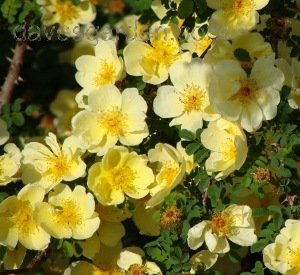
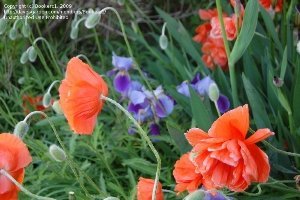
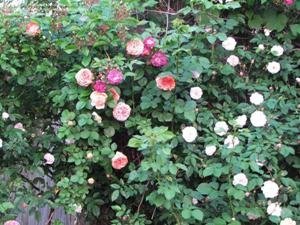
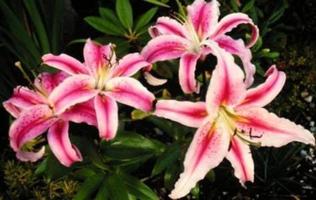
Mr. Craven—Colin's father—decides unexpectedly to return from wandering around Europe to visit his son at Misselthwaite. Despite Colin's anxious fretting about where and when their reunion should take place, it happens in the secret garden!
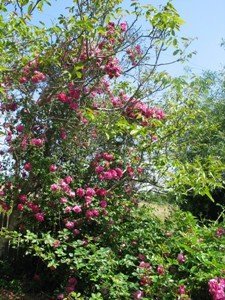 Mr. Craven walks straight to the ivy-covered wall where the door to the garden is—and is surprised by having "the door ... flung wide open, ... and a boy burst through it at full speed." ... It is "a tall boy ... glowing with life." ...
Mr. Craven walks straight to the ivy-covered wall where the door to the garden is—and is surprised by having "the door ... flung wide open, ... and a boy burst through it at full speed." ... It is "a tall boy ... glowing with life." ...
"This is not what Colin had planned. ... 'Father,' he said, 'I am Colin. You can't believe it.' ... Mr. Craven's soul shook with unbelieving joy. ... And so they led him in. The place was a wilderness of autumn gold and purple and violet blue and flaming scarlet and ... lilies which were white or white and ruby. ... Late roses climbed and hung and clustered and the sunshine deepening the hue of the yellowing trees made one feel that one stood in an embowered temple of gold."
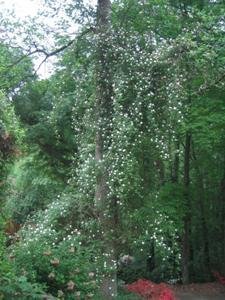
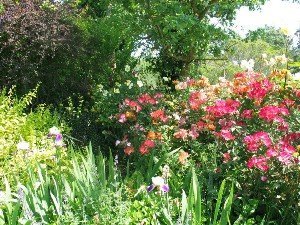
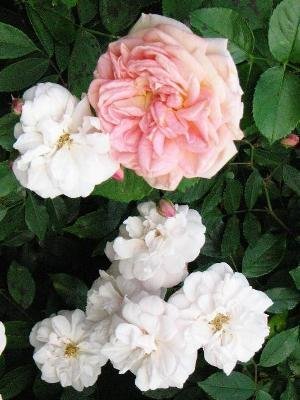
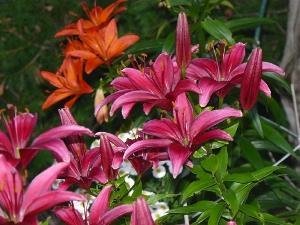





Copyright © www.100flowers.win Botanic Garden All Rights Reserved